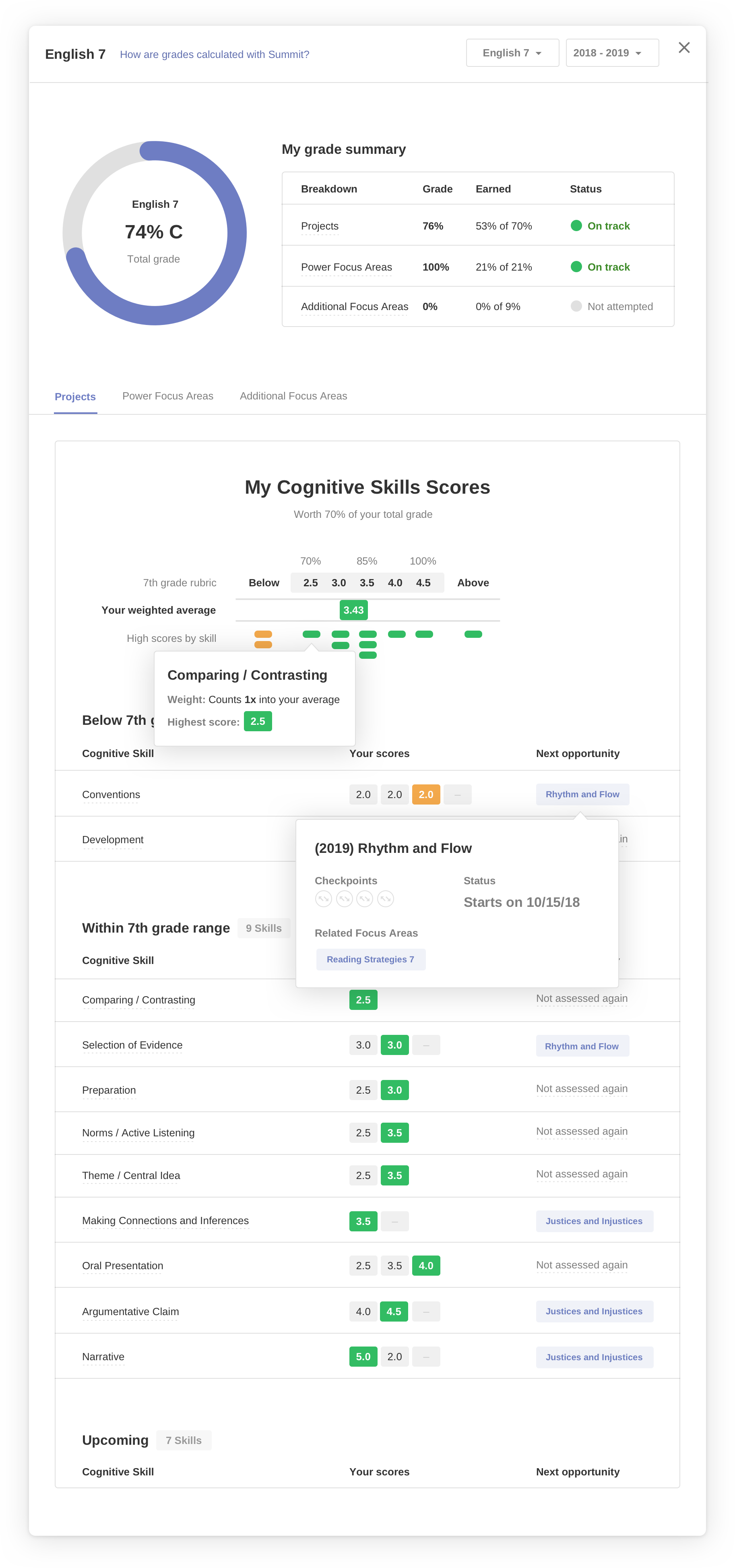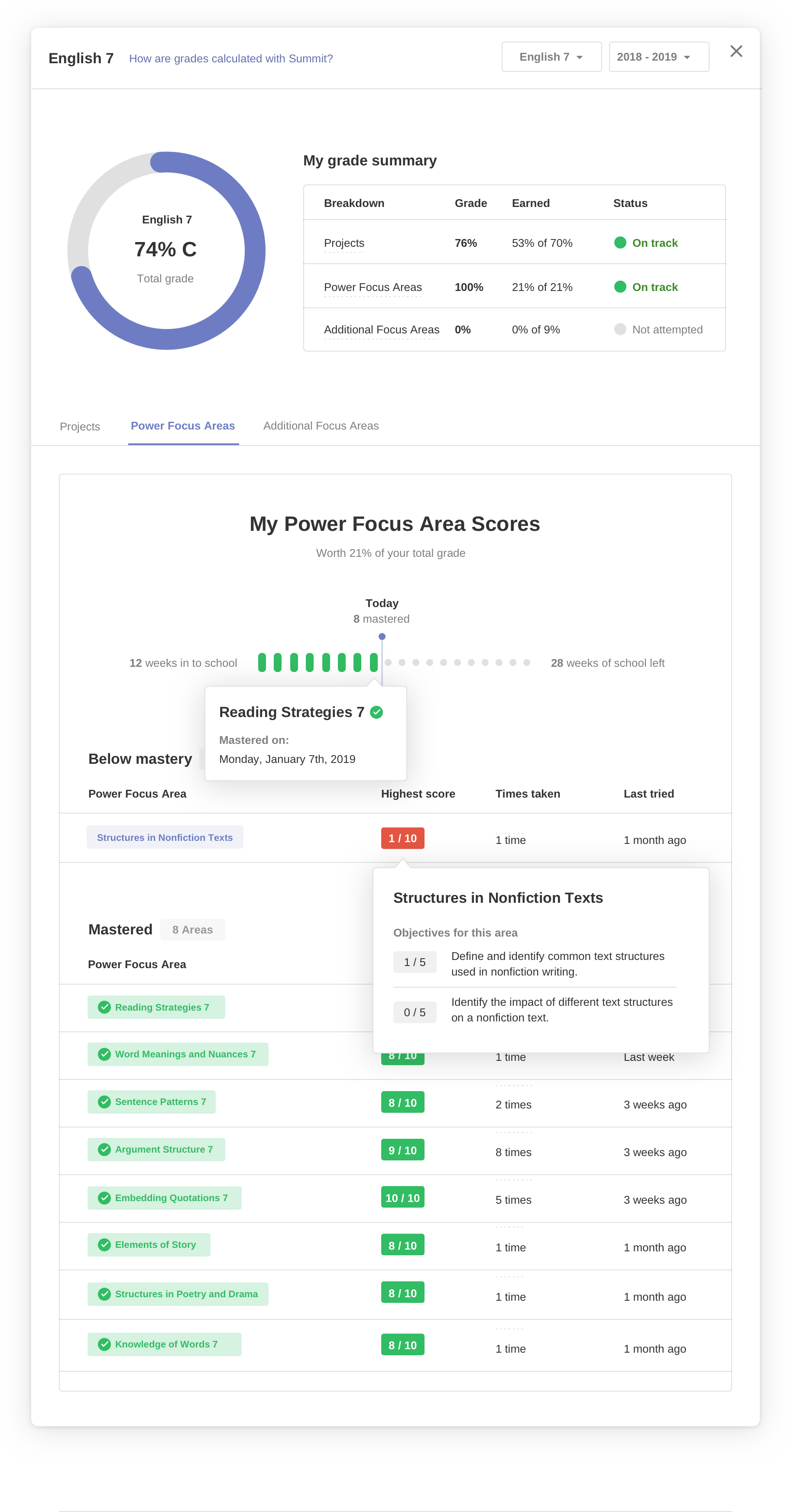With Summit Learning, students are graded on how well they comprehend concepts and can apply what they’ve learned. Rather than simply memorizing information, students focus on developing a strong grasp of class material and effective application of key skills. This sets them up to succeed both within the classroom and beyond.
The main factors that determine students’ grades:

Cognitive Skills—like communication, critical thinking, and articulating a clear point—are at the core of your child’s learning. Cognitive Skills are graded based on how well students apply them to projects.
- Students work on projects that relate to the real world, which require them to produce a final product (such as an essay or presentation).
- Most Cognitive Skills have a rubric score between 0 and 8 (each number score corresponds with a % score). The highest scores per skill are averaged to calculate students’ overall Cognitive Skills score.
- Cognitive Skills can make up to 80% of a student’s overall grade.*
*Dependent on your school's grading system. The school determines how much each factor makes up students’ grades per course. This helps your school establish a grading system that best serves the needs of each course.
Focus Areas ensure that students develop foundational content knowledge of a given subject area. Students demonstrate that they’ve grasped the subject matter by completing and passing Content Assessments. Note that students can take Content Assessments as many times as needed. This ensures that they move on only when they gain a full understanding of the subject.
There are three types of Focus Areas:
- Power Focus Areas (PFAs) contain required areas of content knowledge for a given course. Students must complete all PFAs to avoid receiving an “incomplete” grade by the end of the grading period.
- Additional Focus Areas (AFAs) contain complementary areas of content knowledge for a given course. Students are not required to complete AFAs in order to pass a course.
- Challenge Focus Areas (CFAs) aren't required areas of content knowledge and don’t impact a student’s grade. CFAs are available for students who want to go above and beyond or prepare for standardized tests.
Focus Areas can make up to 20% of a student’s overall grade.*
Portfolio Problems are math problems that accompany each Math Unit. Portfolio Problems apply to math courses only. They’re scored based on how well students apply what they’ve learned to solve complex math problems.
- Portfolio Problems are scored on a 2-point rubric (with half-point increments).
- Portfolio Problems can make up to 10% of a student’s overall course grade.*
Unit Assessments are the final assessments for each Math Unit. Unit Assessments apply to math courses only. They include a range of Portfolio Problems learned throughout a Math Unit.
- Unit Assessment final scores are represented as a % grade.
- Unit Assessments can make up to 70% of a student’s overall course grade.*
*Dependent on your school's grading system. The school determines how much each factor makes up students’ grades per course. This helps your school establish a grading system that best serves the needs of each course.
There’s no such thing as Ds with Summit Learning
Anything lower than a C- grade is considered “off track.”
An “off track” grade means that a student is:
- Not meeting Cognitive Skill or End-of-Unit Assessment grade-level requirements (below 70%).
- Behind in one or more Power Focus Areas.
- Overdue to submit a project’s Final Product.
Any course grade that remains “off track” by the end of the grading period will result in an “incomplete” grade.
How to help your child succeed
Regularly checking in with your child is a great way to support their success. Here are a few questions you can ask to get the conversation started:
- What Cognitive Skills are you working to improve?
- What have you learned from your Focus Areas?
- What are some of your learning goals this week?
Staying in-the-know is easy
See how your child is doing in each class by logging into the Learning Platform (make sure to also add your mobile number to receive text updates about your child’s progress*).
If you have any questions about how grades work or how your child is doing, please reach out to your child’s mentor.
How can I see my child's grade summary?
Once logged in with your parent login, visit your child's dashboard, and then go to the Progress Page. The grades panel on the right side gives the current academics grades. Courses with grades are on or ahead of pace. Courses with Incomplete need attention.
The student grade summary is a circular graphic detailing how project and focus area grades contribute to the final course grade. Explore the separate tabs to see a breakdown of your child's project and focus area scores.
Specifically, the summary includes:
- A circular visual displaying course grade and breakdown showing how project and focus area progress contributes to the final grade.
- Interactive tooltips explaining the grade or status.
- A projects / math concepts tab displaying all cognitive and/or math concept skills accessed and well as future skills that will be accessed.
- A power and additional focus area tab making it clearer to see how many assessments have been mastered, and attempted.
Projects / Math Concepts Tab

Power Focus Areas Tab

Additional Focus Areas Tab


